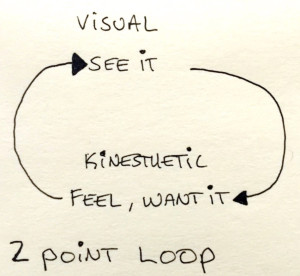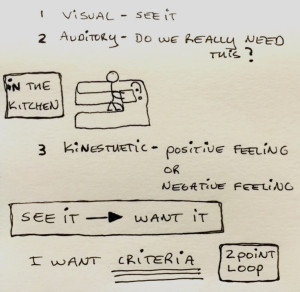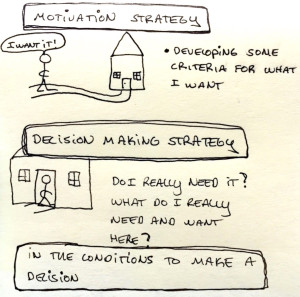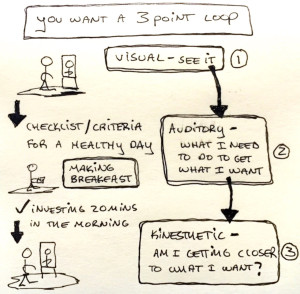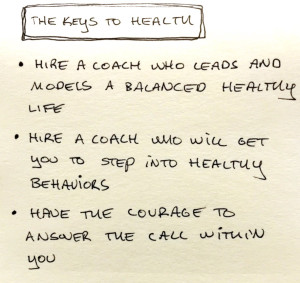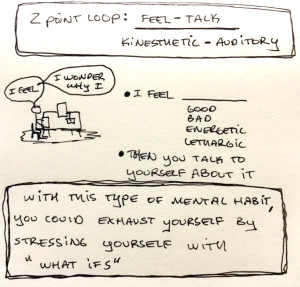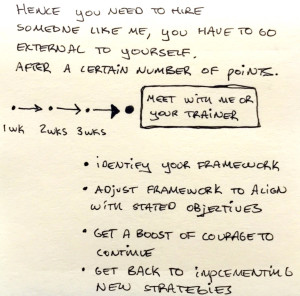Buying A House, And Looking At Yourself In The Mirror.
- What Does It Mean To Be Healthy.
- (The Process Of) Health Re-Visualized
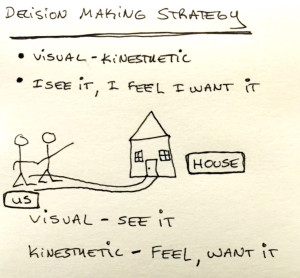 Recently my wife and I started our search for a home. We knew a couple of things starting off. We had a list of criteria when we started off. And we are grateful we did. We heard stories about friends and family members who went house hunting, saw what they wanted, and scrambled to get what they wanted. When you see something and you want it, I call this the motivation strategy.
Recently my wife and I started our search for a home. We knew a couple of things starting off. We had a list of criteria when we started off. And we are grateful we did. We heard stories about friends and family members who went house hunting, saw what they wanted, and scrambled to get what they wanted. When you see something and you want it, I call this the motivation strategy.
I see this often when working with clients as a personal trainer, bodyworker, and coach. People see something and they want it.
When I was a kid, for me, I wanted to be just like my sports hero Cal Ripken. He was able to play the sport of baseball at a high level over such a long period of time. I remember looking up to him and wanting to be just like him as an athlete.
Over the past couple of weeks we have seen 5-7 houses. When we went inside of them, and experienced what they felt like inside, our criteria changed. One home we went in because we loved the pictures on the Internet. And once we were inside, the flow of the house felt yucky. Another house we saw online did not impress us, we wanted a good sample of houses, and so we went besides our first impression. We were delighted by the space and layout of the home. Pleasantly surprised. We started to develop different criteria, what we actually wanted in a home started to evolve with the experiences. After each house we were better able to describe what we wanted in our optimal home.
A couple of things about our experiences started to become apparent. Yes, on one hand we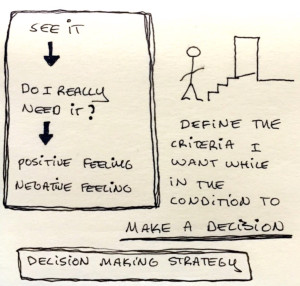 knew what we wanted in a home before we started. At least we knew the rough idea of what we wanted. However, after each visit to the different homes our criteria started to evolve. We started to define what we wanted in a home with more specifics. We were better able to say what we wanted and what we did not want with greater certainty. I came to label this experience distinctly as our decision making strategy. First, we were motivated to buy a house and in that stage we had a rough idea of what we wanted. Once we entered the decision making stage we were in the conditions to make a decision. Then we started to define the exact or with more certainty the criteria we wanted in our home to be.
knew what we wanted in a home before we started. At least we knew the rough idea of what we wanted. However, after each visit to the different homes our criteria started to evolve. We started to define what we wanted in a home with more specifics. We were better able to say what we wanted and what we did not want with greater certainty. I came to label this experience distinctly as our decision making strategy. First, we were motivated to buy a house and in that stage we had a rough idea of what we wanted. Once we entered the decision making stage we were in the conditions to make a decision. Then we started to define the exact or with more certainty the criteria we wanted in our home to be.
When I think about it, I am fascinated to see two distinct stages in our experience. First, we were in a motivation stage. I will now use the word I to refer to my wife and me. I had some criteria, and I was definitely motivated to buy a house. Then, once in the conditions to make a decision, I started to think about what I really needed to be happy and satisfied. Did I really want a gas stove or could I live with electric? Did I want to pay the extra cost for natural light or not? With each criteria came a price. When I thought of a convenient drive from work, I had to consider how much I wanted that convenience. How much money would I pay for the drive, is essentially what it came down too.
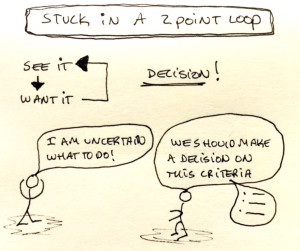 At this point, we found a house we wanted to buy. What we saw was perfect, and as you could imagine, we were sticker shocked. We had to pay that much to get all of the things on our list? For a little while, we were emotionally overly invested in the decision. Oh my, my wife said, I am not sure I want to pay that much for a home. She was worried about draining the savings we have. Once the initially emotions settled we had a nice conversation. Well, I asked, it does meet all of our criteria for a happy home. These were the criteria we had developed over the many visits to other homes. We had a top four list of criteria that we had developed. We decided to use the criteria to make the decision, we trusted our criteria, not necessarily our emotions. On one hand we wanted it, on the other hand, we did not want to pay the price for what we wanted. However, to take emotions out of our equation we used our criteria. Does it meet this? Yes. Does it meet that? Yes. Ok, we would be satisfied and without regret if we purchased this house? Yes. Ok, let’s do it!
At this point, we found a house we wanted to buy. What we saw was perfect, and as you could imagine, we were sticker shocked. We had to pay that much to get all of the things on our list? For a little while, we were emotionally overly invested in the decision. Oh my, my wife said, I am not sure I want to pay that much for a home. She was worried about draining the savings we have. Once the initially emotions settled we had a nice conversation. Well, I asked, it does meet all of our criteria for a happy home. These were the criteria we had developed over the many visits to other homes. We had a top four list of criteria that we had developed. We decided to use the criteria to make the decision, we trusted our criteria, not necessarily our emotions. On one hand we wanted it, on the other hand, we did not want to pay the price for what we wanted. However, to take emotions out of our equation we used our criteria. Does it meet this? Yes. Does it meet that? Yes. Ok, we would be satisfied and without regret if we purchased this house? Yes. Ok, let’s do it!
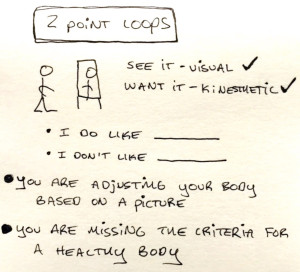 Now what I found interesting was the parallel between my experience of purchasing a home, and my experience of helping to coach clients. Usually when I start working with clients the initial stage is determining the criteria. Have you ever looked at yourself in the mirror and wanted to change something? Maybe you wanted to be bigger? Or lose weight? Maybe you saw yourself moving on video and you decided you wanted to move better? All of that falls under the stage of motivation. What you see you want to change, you feel you want a change. How you actually make the change, what habits or behaviors you need, still have yet to be defined. You have motivation criteria, and you are still in need of the criteria to make the thing happen.
Now what I found interesting was the parallel between my experience of purchasing a home, and my experience of helping to coach clients. Usually when I start working with clients the initial stage is determining the criteria. Have you ever looked at yourself in the mirror and wanted to change something? Maybe you wanted to be bigger? Or lose weight? Maybe you saw yourself moving on video and you decided you wanted to move better? All of that falls under the stage of motivation. What you see you want to change, you feel you want a change. How you actually make the change, what habits or behaviors you need, still have yet to be defined. You have motivation criteria, and you are still in need of the criteria to make the thing happen.
The first stage, the motivation strategy is a 2-point loop. You see it and you feel you want it. The next stage is a 3-point loop. You see it, you have some criteria to meet or match, and you have an overall feeling, either positive or negative. Maybe you want to eat differently? You saw something in a magazine or a picture somewhere and you want to try to make the change. You now have a list of criteria to help you to make the decision. Similar to our home buying, you may have started off with some criteria, and found that as you did research your criteria changed and evolved. Maybe you were surprised to find the opposite of what you expected? Maybe you started eating vegetarian to lose weight and found yourself eating more than usually so you gained weight? The interesting point here to know is that you are in the next stage. You are in the decision-making stage. Here is when your criteria evolve as you are able to define with more clarity what you want in your life and from your body.
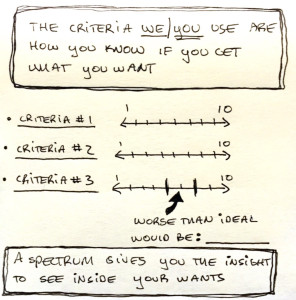 One of the interesting things I notice in the behavior of clients, and humans really is that criteria help us to get what we want. However, often humans are afraid to have what they want. Sound confusing? Stay with me. Lets use breakfast for example. You might know you want to eat a certain ratio or type of breakfast. Ok? You may find yourself in a situation where you what you want is not available and you still have to make the decision to eat breakfast. What do you do? Do you make a decision and beat yourself up all day because you had something different then what you wanted exactly? All criteria can be broken down to a spectrum. Maybe criteria can be broken down into an optimal, sub optimal, and no deal type of decision. If you were offered something so opposite to what you wanted to eat for breakfast, you decided it was better to skip breakfast. The interesting thing I notice about human behavior is that we often are inflexible in our criteria.
One of the interesting things I notice in the behavior of clients, and humans really is that criteria help us to get what we want. However, often humans are afraid to have what they want. Sound confusing? Stay with me. Lets use breakfast for example. You might know you want to eat a certain ratio or type of breakfast. Ok? You may find yourself in a situation where you what you want is not available and you still have to make the decision to eat breakfast. What do you do? Do you make a decision and beat yourself up all day because you had something different then what you wanted exactly? All criteria can be broken down to a spectrum. Maybe criteria can be broken down into an optimal, sub optimal, and no deal type of decision. If you were offered something so opposite to what you wanted to eat for breakfast, you decided it was better to skip breakfast. The interesting thing I notice about human behavior is that we often are inflexible in our criteria.
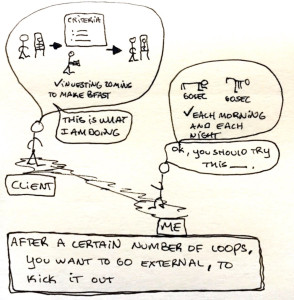 Remember, when you see what you want, you only know what you want by its criteria. Right? When you are able to say what you want, then you are saying the criteria to feel satisfied. The point I am trying to make when you look at criteria is this. No, you may want to change your weight, or look different, and what you are doing is giving you a different result then what you want. Your criteria or habits to help you change are yielding a different result then the one you want. If you keep to yourself, and talk to yourself about what may be working, you may waste time and energy. At this moment, because you are trying to achieve this result on your own you are being inflexible. When you want to achieve a goal or a result, you should have the specific criteria identified and you should be using the right behaviors to get you that result.
Remember, when you see what you want, you only know what you want by its criteria. Right? When you are able to say what you want, then you are saying the criteria to feel satisfied. The point I am trying to make when you look at criteria is this. No, you may want to change your weight, or look different, and what you are doing is giving you a different result then what you want. Your criteria or habits to help you change are yielding a different result then the one you want. If you keep to yourself, and talk to yourself about what may be working, you may waste time and energy. At this moment, because you are trying to achieve this result on your own you are being inflexible. When you want to achieve a goal or a result, you should have the specific criteria identified and you should be using the right behaviors to get you that result.
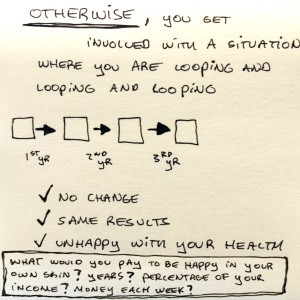 The point is when you failed to get the feedback of achievement you want, and you continue, then you are only going to cause yourself more frustration. When you want to be happy and satisfied in your own skin, and that is your stated criteria, you should learn the criteria and adopt the behaviors to get you there. Just as our criteria for purchasing a home had different stages, so will getting what you want. You will get what you want in stages. Over the course of time you will redefine what you want, and therefore, have to refine how to get what you want. When you stay in your own head, inside your own strategies, you are less likely to get what you want sooner.
The point is when you failed to get the feedback of achievement you want, and you continue, then you are only going to cause yourself more frustration. When you want to be happy and satisfied in your own skin, and that is your stated criteria, you should learn the criteria and adopt the behaviors to get you there. Just as our criteria for purchasing a home had different stages, so will getting what you want. You will get what you want in stages. Over the course of time you will redefine what you want, and therefore, have to refine how to get what you want. When you stay in your own head, inside your own strategies, you are less likely to get what you want sooner.
The keys to health are less complicated then they first appear. In fact, there are over a thousand books that supposedly describe how to get the health level and fitness goals you want. The problem with the usually book is that it misses the description of the small steps for implementing these strategies into your life. It is an art to match the stage of health development you are in with the strategy for success in that stage. Just as in our home buying, there was a different between the motivation and decision making strategies. So there are also different stages you are transiting through on your path to health.
Why would you continue to use the same strategy, the habits and practices you currently use, when you know you are stuck? The problem is you may be less aware then you think. It happens to all of us. I only learned the stages of home buying after going through the stages myself. Your habits or daily practice are formed by the structures and strategies you use. It is easier then you think to become stuck in a 2-point loop where you regret how you spent your effort. It is easier then you think for time to pass you by and for you to be further away from achieving your stated goals and objectives.
Hiring a coach, trainer, or bodyworker is becoming more common these days. Why do you think that is? I think most people are started to realize they need help and they are realizing asking for help is a positive step in the right direction. The facts are simple. You have to get outside yourself and go external even when you have the criteria for meeting your objective. I regularly work with intelligent and successful people in my practice. Some of them want me to write them a list of how to do something and they assume they can achieve it on their own. Self-deception can be tricky. When you set up a regular schedule with a coach like me who is sensitive to your needs, and sensitive to your stated objectives, you prevent self-deception from catching you by surprise.
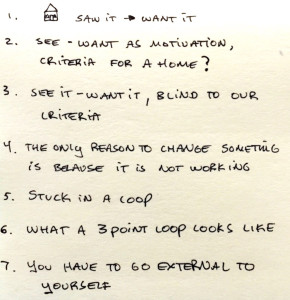 Overall in the picture here you will see the 7 thoughts I wanted to share with you and my motivation for writing this post for you. Please re-read this post. I think you will be surprised how your mind starts to see the world differently over the next couple of days, weeks, or months as a result.
Overall in the picture here you will see the 7 thoughts I wanted to share with you and my motivation for writing this post for you. Please re-read this post. I think you will be surprised how your mind starts to see the world differently over the next couple of days, weeks, or months as a result.
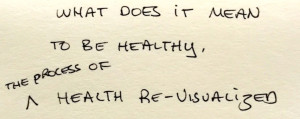 Suppose you asked me to summarize this article in 2 sentences, then I would ask you, what does it mean to be healthy? Should you be re-visualizing what it means to be healthy?
Suppose you asked me to summarize this article in 2 sentences, then I would ask you, what does it mean to be healthy? Should you be re-visualizing what it means to be healthy?
